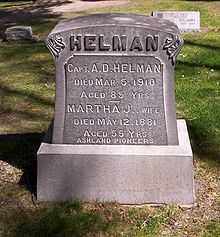Abel Helman

Abel D. Helman (April 10, 1824 – 5 March 1910) was an American pioneer of Ashland, Oregon.
Early life
Helman was born in Wayne, Ashland County, Ohio on April 10, 1824. He was of German descent. He was the fourth of seven children. His youth was divided between work on the farm and education through a subscription school, which was common to that period. On October 23, 1849, he married Martha Jane Kanagy. They had eight children altogether.[1]
Travels
He learned the carpenter's trade in Wooster, Ohio, and worked in cabinet-making until he was twenty-six years old. He heard news of the mid-century gold finds in California from time to time until his desire for fortune led him to make his way to California. In January 1850, he sailed for Aspinwall as a passenger on the steamer Ohio.
In April 1850, he arrived in San Francisco, California, where he made his way to Beaver Creek and eventually on to Sacramento. In 1851, he made a trip over the mountains to the Willamette Valley, Oregon, driving a mule team from Yreka, California, to Salem, Oregon, and while en route he crossed a part of the tract of land that he afterwards took up as a donation claim and upon which a large portion of Ashland, Oregon now sits.
Oregon
He returned to California, and made his home at Yreka until January 1852, when he came to Jackson County, Oregon, with several others, all of whom secured donation land claims. After making preparations for having a home there he returned to Ohio and brought his wife and children back with him to Oregon.
Ashland, named after their old home county in Ohio, became their permanent place of residence. From that time on, Helman was closely associated with the growth of Ashland and the development of his part of the county.
The boundaries of his farm extended north and south along what is now First Avenue above the Chautauqua grove and west on what is now Nutley Street, then north through what is now the old North School grounds almost to Bear Creek. As the town developed, he sold off much of his original tract but at the time of his death was still occupying a portion of the northern part of the claim, about 10 acres (40,000 m2) of land.
Business
Upon moving to Ashland, Helman joined with other settlers in many works of public improvement. They built the first sawmill on the banks of Ashland Creek[2] and the first flour mill which occupied a site near the center of the city that is now Lithia Park.[3] The work of development and progress was not accomplished without much labor on the part of the early settlers. They were forced to endure many hardships and privations incident to pioneer life and in the early days there was constant danger of Indian attack. Helman was with those who defended the interests of the pioneers in the Rogue River Wars of 1855 and 1856, being stationed at a fort on Wagner Creek. His commission as a first lieutenant of the Mountain Rangers, Company A, of the First Regiment, First Brigade, Oregon Militia, was dated December 20, 1865. Helman was elected captain of the Mountain Rangers in 1866. He became the first postmaster of Ashland and continued in that position for twenty-seven years, from 1855 until 1882.
Career
Helman ranked high in the Independent Order of Odd Fellows (I.O.O.F.), having a wide acquaintance among the order throughout the state. He was one of the first members of Ashland Lodge, No. 45, I.O.O.F., and for many years served as one of its officers, filling every position in the subordinate lodge. In 1892, he was grand master of the grand lodge of Oregon. He became a member and past patriarch of the Pilot Rock encampment and he was also grand patriarch of the grand encampment of Oregon. For two years he was grand representative from Oregon to the sovereign grand lodge sessions and he was also prominent in the Rebekah Lodge.
He was interred with the honors of the order, having died on 5 March 1910, at the age of 85.
Helman Elementary school in Ashland, Oregon is named for him.[3]
Sources
The Centennial History of Oregon, 1811–1912, Vol. II: Biographical, Chicago, The S. J. Clarke Publishing Company, 1912, pp. 619–20.